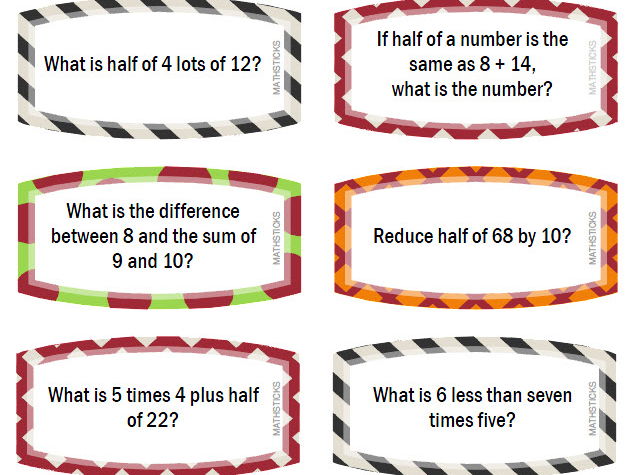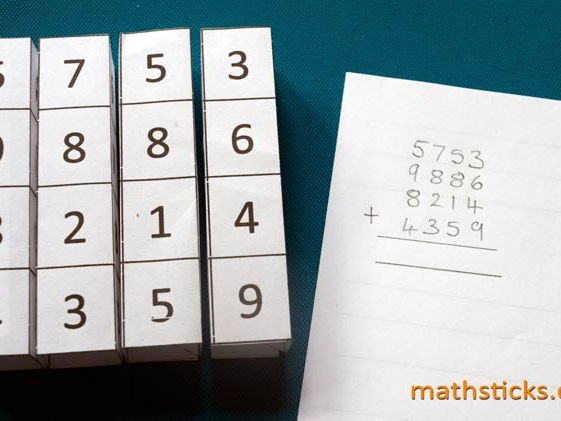
44Uploads
227k+Views
69k+Downloads
Math

100 Multi-step Problems for Y2/Y3
The 6 page pdf file contains 100 two-step problems, such as:
Subtract 12 from the product of 7 and 2
Double the difference between 28 and 41
Multiply a fifth of 20 by 10
Five times a number has the same value as 28 + 17. What is the number?
This maths activity focused on helping children to work out what to do when faced with a two-step problem.
Working with thinking partners, each child has a problem card.
They take it in turns to read it out and discuss how it could be attacked; discussing what maths functions they need to apply in order to solve the problem. Importantly, they must also decide on the order of those functions and be prepared to explain everything to each other.
The focus (as with most mathsticks resources) is very much on the maths talk.
This is a very useful activity for either the introductory or plenary phase of a lesson with children working together on mini whiteboards.
The maths problems could also be used as part of group activity. Naturally, the focus is on the mathematical talk and the decisions the children make regarding the problem rather than on the actual “answer”.
The problems here could easily be adapted or enhanced. In a following session the children could be asked to create their own problems, using these as a template, but focusing on specific concepts: subtraction and percentages, for example.
10 pages with 10 problems each - print, cut out, laminate, use and re-use.
If you use this, please rate the resource so others can find it, and post a comment to let me know how it worked for you.

Teaching Roman Numerals
This 53 page eBook is is a full discourse on how to teach Roman Numerals (properly)
The book includes mathsticks unique “Five Stages of Teaching Roman Numerals” together with a bumper collection of information sheets, posters and assessment materials for teaching Roman Numerals.
If you are teaching about Roman Numerals – you will do it 100 times better with this eBook!

Hidden Roman Numerals
This Roman Numerals activity gives children the chance to focus on the different letters used by the Roman’s to create numbers.
The activity consists of a series of word labels. Each word contains letters that make specific numbers.
For example, in the word ‘drive’, the letters DIV would make the number 504:
D R IV E
The challenge is for the children to find the Roman number “hidden” in each of the words, and to put the words in order.
The download contains four different sets of 6 word cards, instructions and answers.

Maths-Magic Instant Addition
This is more than just an assembly... it's a maths activity that will inspire and entertain. You can also use it as a superb introduction to some great mathematical reasoning for Key Stage 2 or 3.
The downloadable booklet will enable you to instant demonstrate some truly baffling mathematical magic addition.
Imagine hearing this:
3769 + 7972 + 4386 + 8257
…and instantly knowing the answer.
You use a selection of *Squashy Boxes* to create a series of random numbers. Your audience can use a calculator to add the numbers together, or work on paper… it doesn’t matter what they use – you already have the answer!
In fact you can write the answer down the instant you see (or hear) the four random numbers!
The download is a beautifully illustrated, 7-page file detailing the complete workings of the ‘trick’. The file includes all of the resources you need and a number of additional ideas and tips.
The magic trickery can easily be adapted so you can perform the same mathematical-magic with 2-digit or 3-digit numbers too.

16 Dice Games for KS1 & KS2
Here are 16 of our favourite dice games in a 41 page eBook. The maths games focus on addition, subtraction and multiplication for both KS1 and KS2 children. Most of the games have beautifully designed game boards (some have multiple versions of the boards) together with clear instructions and additional ideas for further adaptation and development.

72 Mixed Calculation Challenges for Key Stage 2/3
These quick maths challenges enable children to get quickly into a mathematical frame of mind at the very start of the session. There are 72 short, self contained challenges featuring all four functions. 12 sets of differentiated 'cards' enable children to access the work at their own level.
Importantly, unlike some Challenge on Arrival tasks, marking is negligible with these. It is also very easy to explain what to do, but the tasks are varied and interesting.
The challenges can also provide assessment opportunities and initial ‘talking points’ once the session starts.

Multiplication - Challenge on Arrival #1
Here’s a set of 40 ‘Challenge on Arrival’ cards with a focus on multiplication.
The resource consists of a series of different challenge ‘cards’ suitable for children in Key-Stage 2. The cards come in sets of 4, each set having different multiplication calculations.
When the children arrive in the classroom in the morning (or at the
start of a maths session) its useful to make good use of that time.
Some teachers use Challenge on Arrival task, (sometimes called
“Bell Work”). These are short, self contained tasks, maths challenges
which the children complete as soon as they arrive.
These challenges are useful since they enable children to put themselves quickly into a mathematical frame of mind from the very start
of the session. They can also provide assessment opportunities and
initial ‘talking points’ once the session starts.
Some maths challenges rely on repetition, and can be
uninteresting. The mathsticks Challenges are different.
With our maths challenges…
marking is negligible
explaining what to do is simple
the tasks are varied and interesting so each day is different
there are enough challenges to cater for different abilities
The 10 pages of Challenges each feature a set of Multiplication challenge
grids. Each page is divided into 4 ‘cards’ and each card contains an
incomplete 4-column grid.
The children complete each grid (on their own or with a
partner). The grids are designed so that as well as calculating the children
have to use their reasoning skills. For example, in most grids a number of
the ‘Header’ values are missing and the children will have to use their
knowledge of multiplication and division facts to complete these.
On each grid there are five selected numbers, these need to be transferred to the final column and the last challenge is to sum all of these
numbers.
This final addition calculation produces a Check Number. For ease of marking, this is the only number needed to determine if specific calculations are correct.
The download comes with detailed teaching points and an answer key.

40 Number Square Puzzles for Number Reco
This collection of Number Squares has been designed to support children’s understanding of number order and place value. The materials use three strategies to do this.
Almost every teacher uses a 100 Square to support their children’s understanding of number. But how do you know that your children have a clear understanding of ‘number’ and are not simply regurgitating numerals in order?
Firstly - One very effective way is to use different sized number squares.
This resource features eight different 5 x 5 grids and eight 6 x 6 grids. There are missing numbers and the children have to complete the grids, but only in the white spaces! This helps them to focus on the patterns within the numbers rather than just running mindlessly through the counting numbers… filling squares in without really thinking, 1, 2, 3, 4, 5, 6, 7, 8, 9…
Working with different number squares mean children will discover new patterns (or see old patterns in new ways) and develop a better sense of number order. This leads directly to better understanding and improved fluencey.
Secondly - Working with larger grids with the numbers in ‘standard’ order
The resource contains eight different 10 x 10 grids with the number running in the ‘usual’ left-right formation. Again, only the white spaces need to be filled in - leading the children to focus directly on the number sequences rather.
Thirdly - Using girds where the number order is unexpected
We include a further sixteen different 10 x 10 grids with the numbers starting in different corners and running in different directions, right to left, up to down and down to up!
Children who successfully work with these number grids will really enhance their understanding of number order and number properties.

Times Tables Games – Products and Critters
This 23-page eBook contains two, engaging, colourful multiplication games.
Each is focused on helping children to develop both automaticity and fluency with their Times Tables facts from 2x upto 12x.
The first game focuses primarily on understanding and using multiplication facts. The second game draws out connections between families of facts to further support fluency and understanding.
Each game is perfect for independent paired work.

Christmas Mega Maths Pack
For over six years Mathsticks has been creating great maths resources.
This special festive pack holds all of our ‘Christmas‘ maths resources from 2010 to 2016.
That’s 270 pages of games, puzzles, maths problems and teaching activities (over 120 different resources!) and is a combination of six different mathsticks Christmas eBooks.
The pack includes:
over 30 festive games
more than 50 engaging puzzles
over 26 fascinating problems
a further 14 different Christmas (and/or Star Wars) related resources
120 different Festive resources across 270 pages.
This is 6 years worth of material in one huge download.

Times Tables Activities - Twin Pack
The download contains 4 Mathsticks’ Times Tables Games and Activities. Each game is a carefully focused multiplication resource.
The games are ideal for whole-class, paired work or individual practice situations. Each is designed to offer practice with all of the multiplication facts from 2x to 12x (and a few that extend that range too).
Children will find they are looking for patterns, comparing calculations and faced with multiple opportunities to practice and apply their Times Tables knowledge and develop excellent fluency in co-operative learning situations.











